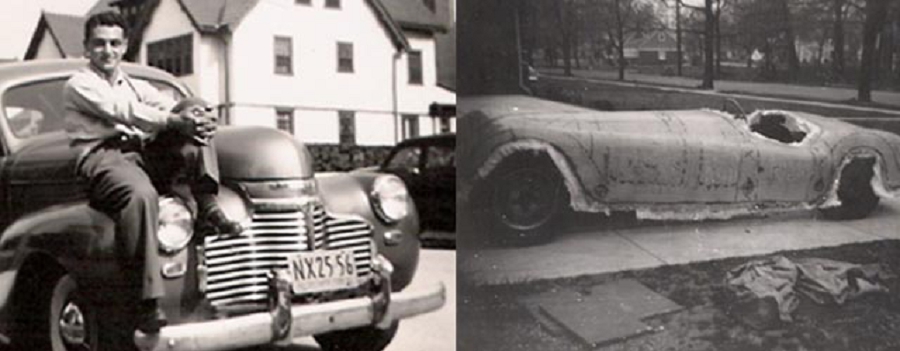
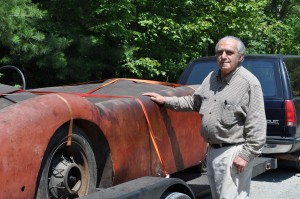
I Finally Had A Chance To Meet With Pat at His Home In Pennsylvania in the Summer of 2011. Here He Checks Out The Gardner Voodoo Sports Car We Had Just Rescued.
Hi Gang…
I first met Pat Amendolia back in 2006. He had a wonderful website where I learned much about Pat, his friend Jim Rockefeller and how they both built fiberglass cars back in the day.
And Pat is quite the entrepreneur and inventor too! Pat is 82 years old and doing great! We’ll talk about his inventions and friendship with Jim Rockefeller in future stories.
Today we’ll focus on a fiberglass sports / race car that Pat built in ’53 called the “Amendolia Chevrolet Special.”
Before focusing on the car, I asked Pat to tell us a bit about himself.
Let’s review what he shared with me.
Pat Amendolia: When and Where It All Began
Geoff….here is my story:
I was a Hot Rodder in 1949, 1950, 1951. I organized a few of my fellow Rodders and was searching for a drag strip on Long Island (L.I.) New York. I even had an insurance commitment from Lloyds of London. When things didn’t work out on L.I., I turned the paperwork and applications, etc. over to a group in Queens, N.Y.
They went ahead with the same name (Long Island Timing Association) that I had set up. I think they went on with it, but really don’t know for sure where it ended up. After I used my customized 1941 Chevy “Hot Rod” coupe for a couple of years, I decided to build a 1926 Chevy Roadster Hot Rod. I designed a chassis with the usual Hot Rod suspension, etc., aimed at straight line acceleration, not the optimum for a sports car.
But, somewhere along the line I decided to make it a sports car with a fiberglass body. So, my sports car was born – a hot rod chassis with a sports car body. A Hot Rod in Sports Car clothing that managed to be in a race against some of the best of the sports car world.
Pat
I then asked Pat to tell us about building his first fiberglass car. Let’s see what Pat had to share with us.
The Amendolia ’53 Chevrolet Special:
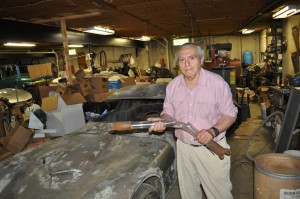
Pat Gave Rick D’Louhy And I A Tour Of His Home and Garage – Lo And Behold He Still Has One Of His Cars – The TDX. More About That Special Car In A Future Story Here At Forgotten Fiberglass.
Geoff…
My first experience with fiberglass reinforced plastics was when I built a body for my sports car in 1953 – we finished the car in early ’54. It was powered by a “hopped up” six cylinder Chevrolet engine. The suspension was Ford transverse springs front and rear with Chevrolet drive train.
I built the chassis in a one-car garage I rented with a dirt floor with no electricity in Oceanside, Long Island, New York. I only worked in the daytime – no electricity was available – but I did my best. I complete the chassis and drivetrain there, but towed it home to my house – also in Oceanside, New York.
I was busy at this time. I got married in ’52 and my dad was a builder – he built the house for us, and we moved to the house in ’53 and that’s where I finished the car – resin and fiberglass completed – all in our brand new garage. I’m sure my new bride was happy about this in every way.
The neighbors were tolerant – I would run the chassis up and down the street to test it.
The chassis was steel channel rails with tubing for the body supports. The gas tank came from a 1926 Chevrolet Super K roadster. Weighing about 1,700 pounds, it was a lively performer. Because it had a six cylinder Chevrolet engine and a fiberglass body, my friends called it “The poor man’s Corvette”.
I raced the “Chevrolet Special” on the SCCA course at Thompson, Conn. in 1954. Because of the displacement of the six cylinder Chevrolet engine, the car was forced to run in class “C modified” and was put into the race with modified Jaguars, a “C” type Jaguar, a 4.1 Ferrari and two special Oldsmobile powered Allards. It was quite a sight!
I have been gathering pictures from my early days and hope to add them to my www.plasticautos.com website one of these days. Although I have several photos of the Chevrolet Special – also known as # 153 – before I made the fiberglass body, I do have a film of when it ran at Thompson Ct. in 1954. I took the film in regular 8mm.
The quality obviously would not be anywhere near regular photos. But, I have pulled images from the film before and used them on my site. Now, I pulled 3 frames which are better oriented for possible identification of the car. They are attached here.
Pat
What a great story about his car! And we have pictures too 🙂 Let’s take a look at the pictures that Pat sent in for this story.
Pictures Of The Amendolia ’53 Chevrolet Special:

Here’s A Road Test Of The Chassis – The Ford Towing The Chevy Special Is Just Ahead of Pat’s Chassis.

This Was Taken at The Rented Garage Without Electricity – Here’s A Rear View Of The Chassis – A Young Fan Of Pat Amendolia’s Looks On From the Passenger Side Curb.
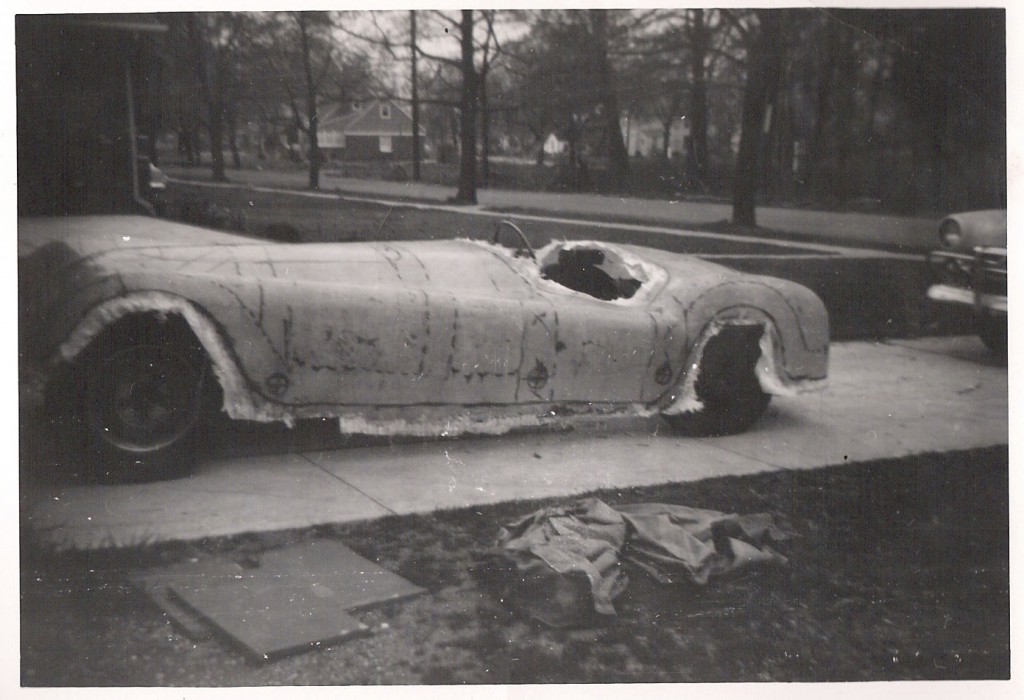
Body Shell For Pat’s Chevy Special in Progress In His Driveway – That’s The Best Place To Work – Isn’t It???
Recently I pressed Pat for more information. Here’s some of what he sent me:
Engine Specifications:
- The original 1941 Chevrolet 216 cu in block was bored 1/8 inch oversize increasing the displacement to 232 cu in. Stroke was 3 3/4 inches.
- The 1938 Chevy head was cut 1/4 inch to increase the compression.
- GMC Stellite valves were set in recessed seats and the flow areas relieved.
- Intake ports were reamed and polished.
- Stromberg 97 carburetors were mounted on a dual Edmunds manifold. Exhaust system was stock Chevrolet. Distributor was a dual point Mallory with a large external capacitor.
- The camshaft was 3/4 race Iskenderian.
- An aluminum timing gear replaced the stock fibre gear.
- Tubular push rods replaced the solid originals.
- A truck flywheel and clutch assembly, uncut, transmitted power to a 4.44 ratio Chevrolet rear.
- The transmission was a standard 1937 Chevrolet 3 speed with a custom floor shift linkage.
- It was never determined how much the horsepower was increased from the original 93 hp stock Chevrolet, but I estimated it was probably in the area of 150 hp.
- The maximum rpm measured was approximately 5,000 rpm in second gear when it was in my 41 Chevy.
- The Chevy would do 0 to 60 mph in about 10 seconds, very respectable for its day.
Chassis Specifications:
- Front end was Ford wishbone with suicide mounted spring and tubular hydraulic shocks.
- Steering was 1937 Chevrolet box and Ford linkage.
- Rear end was Chevrolet with Ford spring and wishbone split and mounted outside on left and right frame rails which were Z’d 1929 Essex.
- Drum brakes were Ford front and Chevrolet rear with 1937 Chevrolet master cylinder.
- Tires were standard 6.00 x 16 on stock Chevrolet and Ford wheels.
- The radiator was stock Chevrolet but was changed during the Thompson race to a larger one from an Oldsmobile in an attempt to solve the overheating problem. Didn’t help much except to increase the time before overheating.
Pat went on to share the following information:
“We built the chassis in a rented garage that had a dirt floor and no electricity. All chassis work was done without the benefit of electricity. All metal cutting and hole “drilling” was done with an oxyacetylene torch. The holes were cleaned and filed to bolt size by hand. All welding was done with the oxyacetylene setup.”
Summary:
Although Pat has not seen his ’53 special for many years, he’s hopeful that we may be able to find it with the help of the Forgotten Fiberglass Fanatic Fanbase out there. And amazingly, Pat still has the original 6 cylinder engine – and it’s ready to go back in the car.
What a amazing site that would be again for all of us here. At the very least, someone may recognize the photos and the car and, with a little luck, may be able to share with us what they remember as part of the car’s history. We’re always optimists here 🙂
So…. Let us know what you think gang. What fun this would be to reunite a man and his car 🙂
Also, be sure to check out Pat’s website for additional history of all his cars, projects, and interests. Click here to visit Pat’s “Plastic Autos” website. Also, click here to learn more about Pat’s other inventions discussed on his “Inventor Pat” website.
Pat is one interesting car guy that I’m honored to call a “friend.” I look forward to our frequent conversations and hope to see him during my next trip to the Northeast later in 2012. By then we may be ready to talk about another of his cars – the TDX. But that’s for a future day here at Forgotten Fiberglass.
Hope you enjoyed the story, and until next time…
Glass on gang…
Geoff
——————————————————————-
Click on the Images Below to View Larger Pictures
——————————————————————-
- I Finally Had A Chance To Meet With Pat at His Home In Pennsylvania in the Summer of 2011. Here He Checks Out The Gardner Voodoo Sports Car We Had Just Rescued.
- Pat Gave Rick D’Louhy And I A Tour Of His Home and Garage – Lo And Behold He Still Has One Of His Cars – The TDX. More About That Special Car In A Future Story Here At Forgotten Fiberglass.
- Here’s A Handsome, Young Pat Amendolia With His ’41 Chevrolet. One Cool Cat!
- Pat’s Friend Ron Ames Is Shown Here Working On Pat’s ’41 Chevy.
- Here’s A Road Test Of The Chassis – The Ford Towing The Chevy Special Is Just Ahead of Pat’s Chassis.
- Here’s A Closeup Of The Engine Used On The Road Test – Performed on Cornwell Road.
- Here’s A Shot of Pat With His Chassis On The Driveway of His Home – Car In Progress 🙂
- Here’s A Rear View Of The Chassis – A Young Fan Of Pat Amendolia’s Looks On From the Passenger Side Curb.
- Aha! Now We Find Pat Working on his own ’41 Chevrolet In This Photo!
- Another Close-up Of The Engine and Chassis in Pat’s ’53 Chevrolet Special
- Body Shell For Pat’s Chevy Special in Progress In His Driveway – That’s The Best Place To Work – Isn’t It???
- Pat’s ’53 Chevrolet Special – in Race Trim in Connecticut.
- Pat’s ’53 Chevrolet Special – in Race Trim in Connecticut.
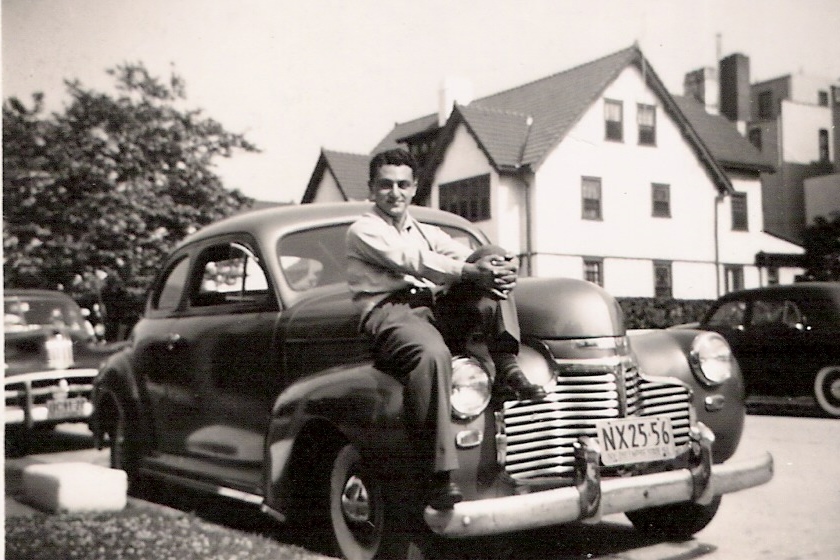


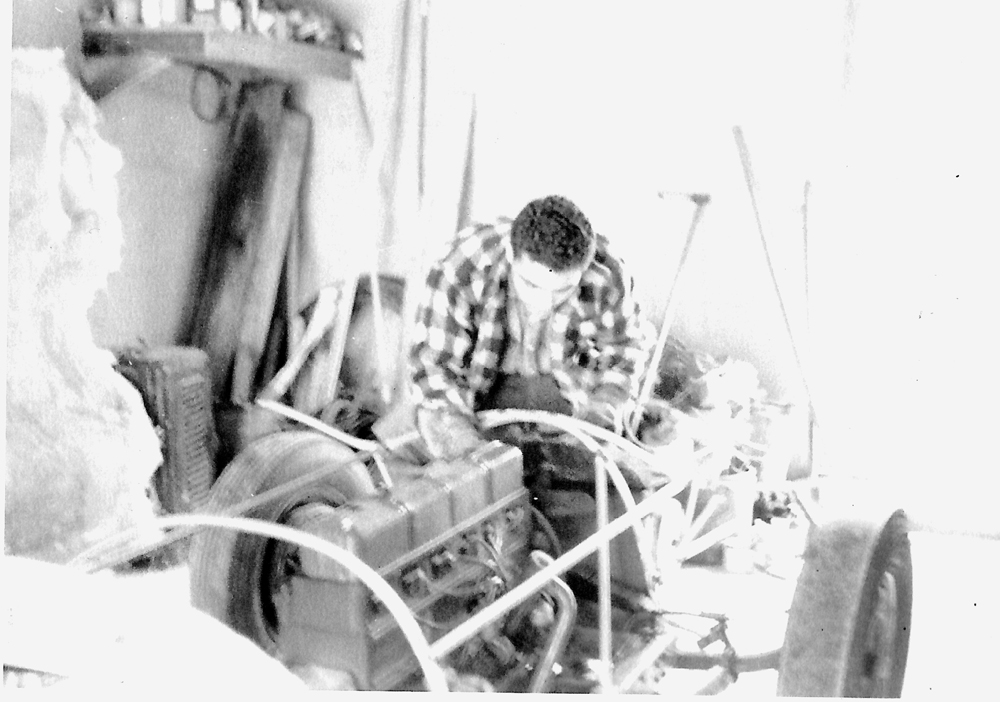
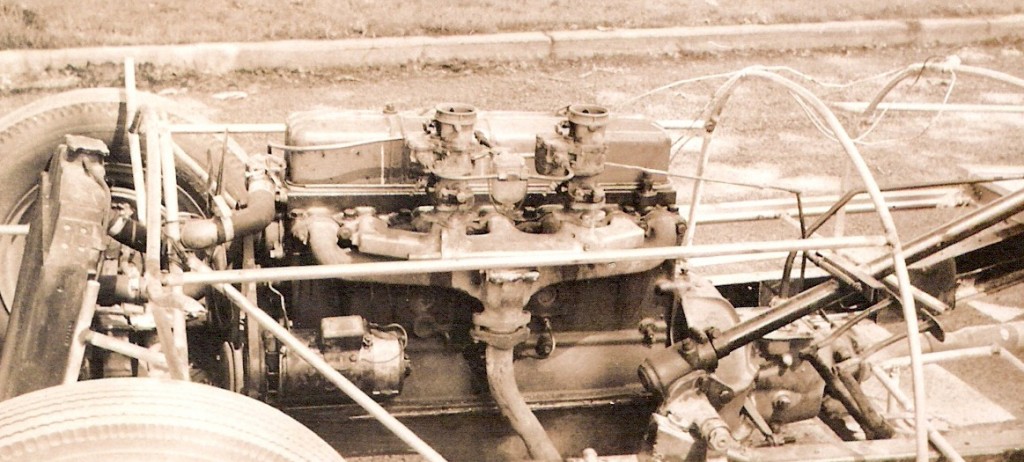

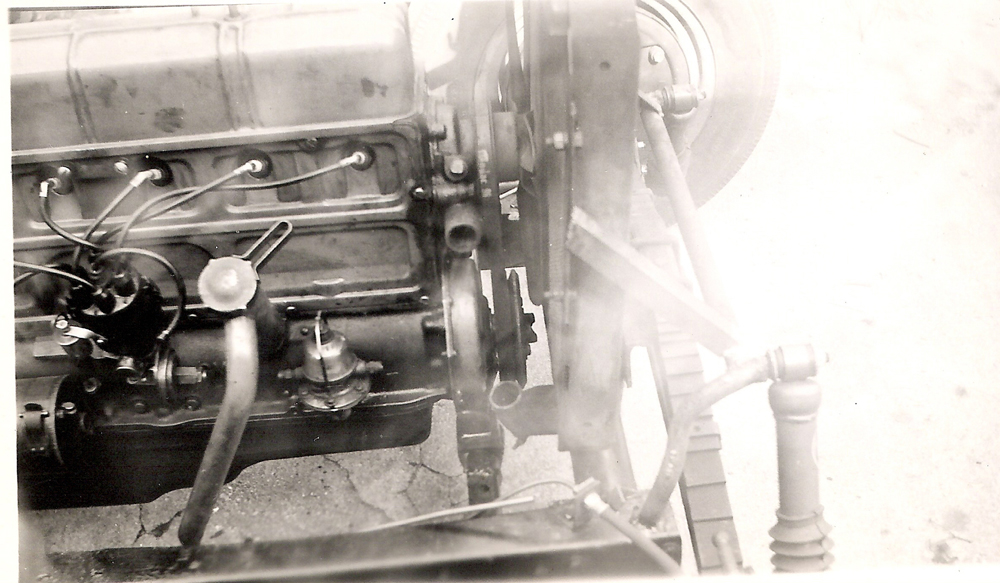





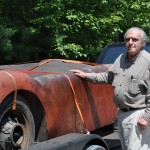
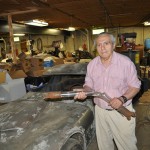
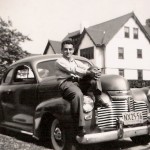
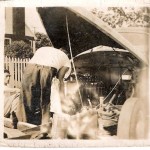
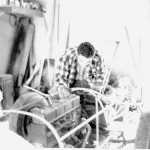
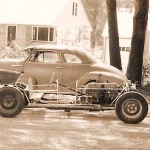
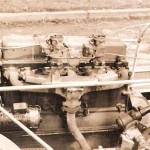
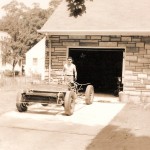
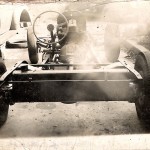
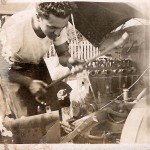
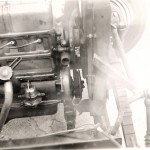
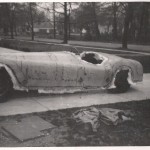
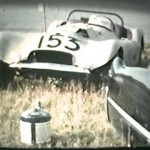
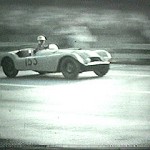
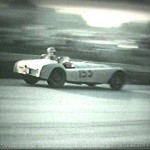
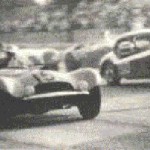
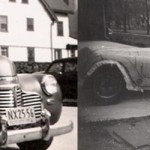
Great story about the way we did things “back in the day”. Often starting with little more than a dream and lots of determination, in retrospect, it’s really amazing what we were able to accomlish. I especially liked the part about no electricity. That’s no electricty, gang, to power anything, even lights! Who could even imagine thinking about a project like that today, much less actually plunging in with the full intent to complete and drive and, in this case, race the car against who knows what. But it was more fun than anyone can imagine.
I’ve always said, if we really knew how daunting the task was when we started, it would never have been begun. Much can be said for the irrational exuberance of youth! Hats off to Pat for his project and for a remarkable story.
An ineresting collection of parts not unlike what was being used to build the sprint [dirt track] cars that ran in the late 1930s and early 1940s. A remolded banjo Chevy steering wheel like this one runs from about $1,500 to $2,000 today if you can find one. It is also interesting that a Chevy steering box was used. They were generally better than Model A but the Ford linkage was much better steel than the GM stuff.
This is a really great piece of American road racing history! Thanks Geoff for bringing yet another classic sports racing special from the 1950s to my attention.